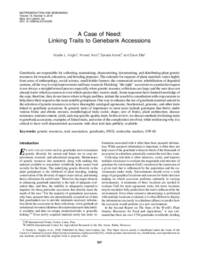A Case of Need: Linking Traits to Genebank Accessions

Authors:
Genebanks are responsible for collecting, maintaining, characterizing, documenting, and distributing plant genetic resources for research, education, and breeding purposes. The rationale for requests of plant materials varies highly from areas of anthropology, social science, small-holder farmers, the commercial sector, rehabilitation of degraded systems, all the way to crop improvement and basic research. Matching ‘‘the right’’ accessions to a particular request is not always a straightforward process especially when genetic resource collections are large and the user does not already know which accession or even which species they want to study. Some requestors have limited knowledge of the crop; therefore, they do not know where to begin and thus, initiate the search by consultation with crop curators to help direct their request to the most suitable germplasm. One way to enhance the use of genebank material and aid in the selection of genetic resources is to have thoroughly cataloged agronomic, biochemical, genomic, and other traits linked to genebank accessions. In general, traits of importance to most users include genotypes that thrive under various biotic and abiotic stresses, morphological traits (color, shape, size of fruits), plant architecture, disease resistance, nutrient content, yield, and crop specific quality traits. In this review, we discuss methods for linking traits to genebank accessions, examples of linked traits, and some of the complexities involved, while reinforcing why it is critical to have well characterized accessions with clear trait data publicly available.
